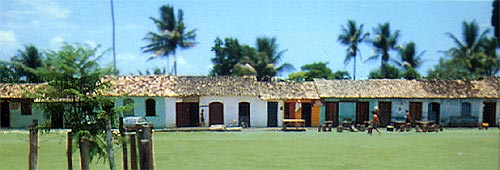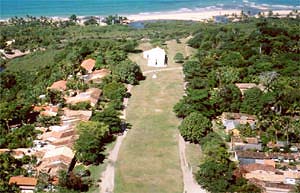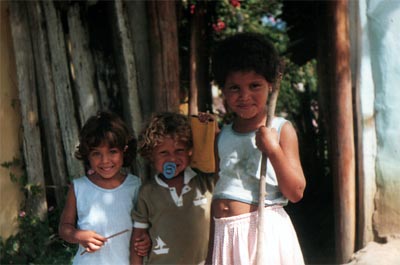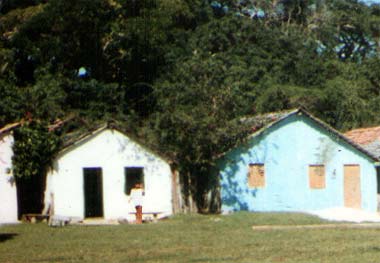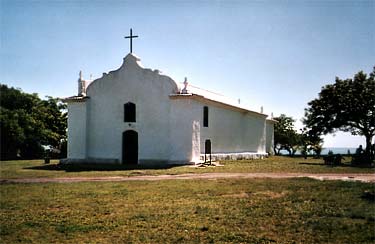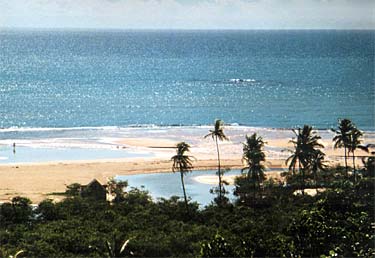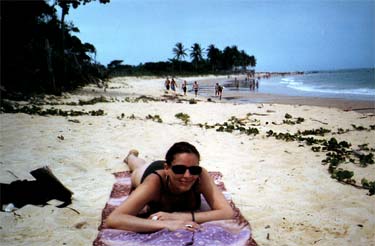| |
|
|
|
|
| |
|
|
|
| |
|
|
|
|
| |
|
the houses opposite of our place |
|
|
| |
|
|
|
|
| |
|

|
|
|
| |
|
|
|
|
| |
|
Trancoso
is situated on a grassy bluff overlooking the ocean and miles of fantastic
beaches. The village belongs to the prefeitura of Porto Seguro, a historical
small town on Brazil's northeastern coast popular both with foreign and
Brazilian tourists. Trancoso's central square, known as quadrado,
is lined with small, colorful colonial buildings and casual bars and restaurants
nestling under shady trees. |
|
|
| |
|
|
|
|
| |
|
The history
of Porto Seguro, which means 'safe port' in Portuguese, and actually of
the whole of Brazil, begins on April 22, 1500, when Pedro Álvares
Cabral's squadron saw from a distance a rounded elevation - Monte Pascoal,
that lies south from Porto Seguro. In search for a safe place to moor, the
thirteen caravels sailed along the coast heading north and finally anchored
at a large bay of deep waters, a little before the evening of April 24.
The place was later called Baía Cabrália where presently is
situated the town Santa Cruz Cabrália. When Cabral departed, on May
2, he left two men banished from Portugal whose mission was to learn the
language and customs of the Tupiniquim Indians, besides two sea boys who
deserted to adventure in the luxuriant tropical woods. That was the beginning
of the occupation of the new lands by the white men. |
|
|
| |
|
|
|
|
| |
|
On November 9th of 1759, the year the Jesuits got kicked out of Brazil,
Trancoso, by royal decree, was elevated from aldeia (village) to
vila (township). At this time the place consisted of 62 houses, 14
of those had shingled roofs. 500 indios living from fishing and the cultivation
of cassava lived in Trancoso. A mid-eighteenth-century list of missions
administered by the Jesuits classifies the inhabitants at Trancoso at that
time as "Tupinikins or Tabajaras mixed with Tupinan" |
|
|
| |
|
|
|
|
| |
|
|
|
|
| |
|
an
aerial view of Trancoso that I found on the web |
|
|
| |
|
|
|
|
| |
|
Even as
late as 1820, export agriculture had failed to take firm root in Porto Seguro;
despite the growth of production for local markets, the region remained
a poor backwater where settlers still worried about Indian attacks. Settlers,
royal officials, and backwoodsmen in southern Bahia were all too aware that
Indians remained a very real "issue" and that the nearby forests
were not empty, uninhabited space. While settlers counted on the labor of
"tame" Indians who were drafted to clear fields, open roads, and
cut timber, they also had to remain on constant watch for any sign of "wild
heathens," whose raids and attacks could lay waste to a fledgling commercial
economy. |
|
|
| |
|
Efforts
were aimed at a creating a stable and productive Indian peasantry through
a combination of coercion, forced cultural assimilation, and close supervision.
Although unsuccessful over the long run in halting frontier expansion, Indian
resistance did delay and restrict the development of a strong commercial
economy in the region. An appointed white "director" and a scribe
would now be posted in every Indian aldeia and charged with the
tasks of "civilizing" the Indians, removing them from the "dense
darkness of their rustic ways," and encouraging them to practice settled
agriculture. |
|
|
| |
|
Directors
struggled for years to have Indians replace large palhoças
(thatch huts) that sheltered several couples and their children with brick
and tile houses big enough to accommodate a single couple with their children.
The brick and tile houses did, indeed, directly interfere with the daily
lives of Indians by dividing them into family units that met Portuguese
norms and reinforced notions of Christian morality as taught by parish and
missionary priests.
|
|
|
| |
|
When the
German traveler and naturalist Prince Maximilian zu Wied-Neuwied visited
the Indian town of Trancoso in 1816, he found it virtually empty: "The
inhabitants live on their farms (roças) and come to church
(and hence into town) only on Sundays and on feast days." |
|
|
| |
|
|
|
|
| |
|
Wherever
possible, Indians were to be fully "domesticated"- that is, transformed
into a settled peasantry that would contribute to an expanding commercial
economy and uphold Portuguese rule. But, at the same time, "domestication"
would also clear the way for further Portuguese settlement and ultimately
lead to the complete disappearance of Indians as a distinct group within
the region's population. Direct and open resistance to this project only
subjected the Indian population to even greater pressures, culminating,
in the first decades of the nineteenth century, in one of Brazil's last
official Indian wars. |
|
|
| |
|
By 1820
Porto Seguro had grown to reach a total of over 16,000 inhabitants, including
3,650 Indians. In only two of the comarcas (judicial districts) of
Porto Seguro's nine townships, Vila Verde and Trancoso, did Indians still
account for the majority of the population. |
|
|
| |
|
Even in
the mid-nineteenth century, southern Bahia remained a frontier region of
ongoing contact, accommodation, and conflict between settlers and Indians.
As the trade in cassava flour grew, settlers increasingly displaced Indians.
|
|
|
| |
|
|
|
|
| |
|
The development
of trade and agriculture accompanied population growth in southern Bahia.
The region emerged in the late eighteenth century as an important supplier
of farinha de mandioca (cassava flour) and salted fish for urban
markets within Brazil. Farinha made by farmers in Porto Seguro
was sold not only in Salvador, the Bahian capital, but also in Rio de Janeiro
and in Pernambuco. Trade in farinha allowed settlers in the region
to acquire larger numbers of imported African slaves and Brazilian-born
slaves of African descent. |
|
|
| |
|
From the
1580s onwards, the importation of Africans to Brazil increased dramatically.
The African slaves brought their ‘macumba’ (voodoo) rites
to Brazil. Even today, the candomblé cult is strong in Bahia.
Though, to my disappointment, such traditions were unknown among the locals
of in Trancoso. |
|
|
| |
|
|
|
|
| |
|
Nearly
five hundred years after Cabral, Indians still live around Monte Pascoal
and on reservations elsewhere in southern Bahia. They continue to struggle
against landowners and loggers in the area to hold on to what little land
they still retain. |
|
|
| |
|
|
|
|
| |
|
The local population of Trancoso visibly has both Indio and African traits.
|
|
|
| |
|
|
|
|
| |
|
|
|
|
| |
|
Estrela,
João and Duda |
|
|
| |
|
|
|
|
| |
|
|
|
|
| |
|
|
|
|
| |
|

|
|
|
| |
|
|
|
|
| |
|
Before
the first dropouts from the cities of southern Brazil settled in Trancoso
in the early seventies, the village, populated mainly by only two extended
families, was virtually cut off from the rest of Brazil. |
|
|
| |
|
It
is said that until the sixties, money wasn't used much in Trancoso, and
goods changed hands by way of barter. A local friend told me that when she
was around the age of eight, two girls with lice-infested hair came to the
village. Before those parasites were unknown in Trancoso. This seems to
me about the most convincing proof that previously there really wasn't much
contact with the rest of the world. To go to Porto Seguro meant a tiresome
journey by horse or donkey. |
|
|
| |
|
Only
in the eighties did Trancoso get electricity and a school. |
|
|
| |
|
|
|
|
| |
|
When we
arrived in 1984, conditions were still very minimal. The only store, a small
dark room featuring a few wooden shelves, sold rice, beans and two or three
varieties of local vegetables. On demand the store owner also sold a few
medicines, though the good lady wasn't what I'd call knowledgeable as to
their uses and properties. When my neighbor's daughter suffered from a bad
ear infection, her mother bought a bottle of ear drops at the grocers. After
learning about those drops causing the poor girl terrible pain, I asked
to see the bottle. It contained a remedy for athlete's foot. |
|
|
| |
|
|
|
|
| |
|
|
|
|
| |
|
typical
bar on the village square |
|
|
| |
|
|
|
|
| |
|
There
were plenty of tiny bars bordering the quadrado where the locals
liked to hang out, play snooker and drink pinga, another name for
cachaça, the local sugarcane booze. |
|
|
| |
|
|
|
|
| |
|
Apart
from the buildings lining the quadrado, Trancoso in the early eighties
consisted of only a few dozen houses. A bit further away, landless people
started to build their homes on occupied grounds, according to a Brazilian
law allowing land not used by its owners for a certain amount of years to
be claimed. This section of Trancoso was called invação,
invaded territory. It consisted of barren, sandy soil, not to be compared
with the fertile earth near the village square. |
|
|
| |
|
Most
of the natives lived in simple mud houses: Neighbors and friends join to
throw as much mud on a framework of wooden stakes as is needed to transform
it into a wall. On completion a party with lots of cachaça is
held, so there usually is no lack of volunteers. |
|
|
| |
|
|
|
|
| |
|
|
|
|
| |
|
houses built of stakes and mud |
|
|
| |
|
|
|
|
| |
|
As
to the durability of those constructions, I guess it's not too many years.
While still living in the rented place on the quadrado, one evening
while having dinner sitting around the big table out back, we experienced
the sudden collapse of our neighbor's adjoining wall into a heap of rubble.
For the next few weeks we had a live reality show right in our backyard,
as we couldn't help but witness everything that went on in that family's
now open-to-the-world kitchen. It kind of looked like a stage, with the
actors entering and leaving through two door openings. The head of the family
was an uncouth, insensitive fellow, who loved to terrorize his wife and
the boys at any opportunity. His elder son often hid himself in the bushes
out of fear of his father. When the wife was giving birth to another baby
and complications arose, instead of arranging transportation to a hospital,
her husband left her to the attention of some passing tourist. Only much
too late was she brought to a clinic in Eunapolis, with the consequences
of the baby being dead and the mother not able to ever have another one.
When the poor woman returned home a few days later, her vile husband shouted
at her that she was now "castrated" and useless. |
|
|
| |
|
I
was asked to come over and take some pictures of the dead baby. This was
nothing uncommon in South America, nonetheless, I couldn't do it, I was
afraid not to be able to stand the sorry sight, and that I might faint.
Somebody else went and took the snaps, which we had developed and handed
over later. |
|
|
| |
|
|
|
|
| |
|
|
|
|
| |
|
Trancoso's
historical church |
|
|
| |
|
|
|
|
| |
|
Trancoso's
church, being one of the oldest in all of Brazil, nonetheless didn't even
feature a regular priest. Once in a while some obese red-haired foreigner
appeared to hold a service and to baptize some newborns. Occationally he
had to baptize some teens from families living a bit farther away, who obviously
had included "gotta have those brats baptized" way down near the
bottom of their priority list. |
|
|
| |
|
When he the padre happened to turn up,
hardly any of the local males attended mass, because their drinking habits
inevitably were part of the sermon. |
|
|
| |
|
I only happened to witness the padre
preaching on one single occasion, and was totally dumbfounded to hear him
tell his congregation that animals have no souls. Exactly
the type of stupid misinformation the villagers needed: They treated animals
very cruelly and loved to hunt down and kill anything that moved. |
|
|
| |
|
|
|
|
| |
|
In
the eighties, the church was in a sad state of disrepair. The paint was
flaking off and the wood had partly the consistency of a sponge. With things
continuing that way, it was only a matter of time for the church to be reduced
to a heap of rubble. As this became evident to the public, some of the foreigners
and Brazilian dropouts living in Trancoso recruited volunteers and organized
some renovations. For a full day we all were busy painting and hammering
away. |
|
|
| |
|
|
|
|
| |
|
Once
our own house was ready and my garden in bloom I often got accosted with
demands for armfuls of bougainvillea branches to decorate the church with.
|
|
|
| |
|
|
|
|
| |
|
With
the priest only showing up every few months, Jehovah's witnesses entered
into the religious vacuum of Trancoso. Local converts, their blouses buttoned
up to their chins, started to make their rounds on Sundays, knocking at
doors. |
|
|
| |
|
Millions
of Brazilians are crente, as the adherents of Jehovah's witnesses
and other evangelical sects are called. It seems the Brazilian brand of
Catholicism doesn't meet the requirements of the masses anymore. Fatima
told me that meanwhile there are churches of various sects all over Trancoso.
|
|
|
| |
|
|
|
|
| |
|
The only
water supply for Trancoso was the nearby river, located at the foot of the
plateau on which the village stands, where an old electrical pump noisily
did its job. Often the pump was broken for days or even weeks. This meant
all the water needed for construction and for the restaurant had to either
be hauled up the steep path from the river by locals employed for that purpose,
or it had to be gotten by jeep in jerrycans. |
|
|
| |
|
As the
water pump wasn't located far from the place the villagers used to wash
their clothes, and themselves as well, I thought it safer to buy a simple
clay water filter for our drinking water. I've often drunk river water and
worse on my travels, nonetheless I didn't want us to imbibe all those shampoo
and soap remnants, though of course I couldn't be sure about the filter
being able to get rid of them. |
|
|
| |
|
Washing machines at that time were about unknown in Trancoso.
All the washing was done at the small river below. As I had neither time
nor much enthusiasm to do our washing, which amounted to quite a lot as
it included bed sheets from the guest rooms as well, I paid Seu
Frederico's wife for the job. Whenever Fatima's friends went down
to the river to wash clothes she went along to help them, but she refused
to take some of our own washing along. The girls loved to frolic and play
around in the water. |
|
|
| |
|
To dry, the wet clothing was extended either on some bushes
or preferably on fences of barbed wire. |
|
|
| |
|
|
|
|
| |
|
|
|
|
| |
|
|
|
|
| |
|

|
|
|
| |
|
|
|
|
| |
|
One
of the main attractions of Trancoso is the endless beach, according to Brazilian
Playboy magazine one of Brazil's Top 20. |
|
|
| |
|
|
|
|
| |
|
|
|
|
| |
|
Trancoso
beach |
|
|
| |
|
|
|
|
| |
|
A
great stretch of the beach is owned by some local kingpin and politician.
He hadn't paid for it in money, but rather came into its possession in exchange
for a transistor radio and a set of dentures for its erstwhile owner. At
least that's what local lore tells; it must have happened around the sixties.
I only know for sure that the old owner's descendents were really pissed
off at how their grandfather had gotten cheated. The new owner used to fly
in by chopter, landing right beside Trancoso's church. He often forgot to
pay locals who worked for him, but nobody dared complain. His word in the
right ear got murderers out of jail. |
|
|
| |
|
|
|
|
| |
|
|
|
|
| |
|
Fatima
on visit to Trancoso in 2002 |
|
|
| |
|
|
|
|
| |
|
I have
to admit that beaches are not my thing, I'm more at home in a dry desert
climate. In my four years in Trancoso, I may have visited the beach four
or five times. True, I was usually very busy, but actually I never have
liked wet sand and salty water. I leave that to the tourists. |
|
|
| |
|
A
very old, dark skinned neighbor lady once asked me: "Well, in a way
I understand the white people going down to the beach to get some colour.
But what about the black ones, ain't they dark enough already?"
|
|
|
| |
|
|
|
|
| |
|
The
younger generation of locals started to use the beach for recreation as
well, a habit they picked up from their fellow countrymen from places like
Rio, where the beach plays an important part in a carioca's daily
life. In Trancoso, the native women up to my generation only went down to
the shore to catch some small fishes in the backwaters. |
|
|
| |
|
Zilda,
my neighbor and friend, used to go down to the beach for fishes and crabs
occasionally too. One morning she returned all upset: "You don't
believe what happened, I was all alone in a quiet spot, when suddenly
a naked stranger appeared before me. I've never seen another man save
my husband naked, and I want it to stay that way." Later, she pointed
the offender to her sensibilities out to me: It was an architect from
Rio, a customer of my restaurant. |
|
|
| |
|
The local
menfolks would get real angry at nude male tourists, and loved to threaten
them with their machetes. Nude girls were something else, the same valiant
defenders of morals and decency just stood there drooling. |
|
|
| |
|
I knew a chick that sold rather plain sandwiches, filled mainly with raw
beetroot and far too expensive. This girl usually went down to the beach
with a full basket and only a short while later came back up, all her sandwiches
sold. It was a mystery to me why anybody would buy her tasteless stuff at
such a prize. Until somebody told me that she sold them in the buff. |
|
|
| |
|
|
|
|
| |
|
My
kids loved the beach. Rashid's dream for a time was to become a professional
surfista, a surfer. |
|
|
| |
|
|
|
|
| |
|
|
|
|
| |
|
|
|
|
| |
|
|
|
|
| |
|
|
 |
|

